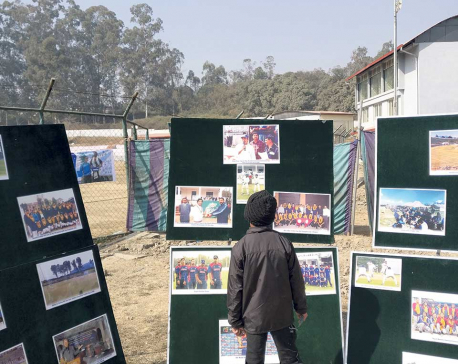
OR
Tapping Demographic Dividend
How can Nepal Take Advantage of its Population Bonus?
Published On: May 13, 2023 08:20 AM NPT By: SHREE RAM SUBEDI

November 15, 2022, marked a monumental milestone in human history as the world's population reached a staggering eight billion. This remarkable growth can be attributed to several factors, including significant advancements in public health, nutrition, personal hygiene, and medicine, which have led to a gradual increase in human lifespan. In addition, persistent high levels of fertility in certain countries have also contributed to this unprecedented surge in population. It's fascinating to think about the impact this burgeoning population will have on our world and the challenges we will face in the years to come.
While it took the global population 12 years to grow from 7 to 8 billion, it will take approximately 15 years — until 2037 — for it to reach 9 billion, a sign that the overall growth rate of the global population is slowing.
In Nepal, on March 24, 2022, the final results of the 12th edition of the national census were unveiled, revealing that Nepal's population has reached almost 30 million. The census was conducted on November 25, 2021, and the results showed that Nepal's population on that day was 29,164,578.
The 2021 census, the first conducted since Nepal adopted federalism, provides valuable insights into the changing demographic dynamics of the country over the last decade and sheds light on population trends for the future. Like many other countries around the world, the census reveals that Nepal's average annual population growth rate has decreased to 0.92 percent in 2021, down from 1.35 percent in 2011 and 2.25 percent in 2001. For the first time in 80 years, Nepal's population growth has remained below 1 percent. This consistent decline is attributed to factors such as low mortality and fertility rates, family planning, higher costs of raising children, and greater reproductive choices for women.
The Nepal Demographic and Health Survey (NDHS), which was recently released, indicates that the fertility rate in Nepal has decreased by 50 percent in just two decades. The NDHS report reveals that the current fertility rate for women in Nepal is 2.1. Moreover, the fertility rate in Nepal has historically decreased from 5.7 births per woman in 1973 to 2 births per woman in 2022. This decline can be attributed to various factors, such as increased access to family planning services, improved healthcare, and higher education for women.
The latest census has highlighted a decline in the population of children under 15 years old due to the decrease in fertility rates. Conversely, the census reveals a rapid increase in the population of people over 60 years old. According to the census, the population aged 14 years and below accounts for 27.83 percent of the total population. The annual population growth rate of this age group has declined by 1.30 percent since the last census in 2011. This decline can be attributed to several factors, including lower fertility rates and increased access to family planning services.
The population of people above 60 years old in Nepal accounts for 10.21 percent of the total population. This suggests that Nepal is transitioning into an aging society. Typically, an aging society refers to a population where individuals aged 65 years and older make up 7 percent or more of the total population. If this proportion exceeds 14 percent, the society is referred to as an 'aged society'.
A 2017 report published by the National Planning Commission and UNICEF predicts that Nepal will become an aging society by 2028 and an aged society by 2054. The report, titled "Demographic Changes of Nepal: Trends and Policy Implications," stresses the importance of taking advantage of the demographic opportunities that are available to Nepal. It is crucial to act promptly to capitalize on these opportunities to prepare for an aging population and ensure the long-term sustainability of the country's social, economic, and healthcare systems.
The latest census reflects the recommendation made by the NPC and UNICEF report, revealing that 61.96 percent of Nepal's total population falls within the age range of 15 to 59 years. This is an increase from 56.96 percent in 2011. Additionally, the 2021 census reports that 65.5 percent of Nepal's total population is economically active.
This means that Nepal is currently benefiting from a demographic dividend, specifically a "population dividend" or "youth bulge," in which young people comprise the largest portion of the population. It is worth noting that persons aged 10 years or above are considered economically active. Experts believe that this presents a unique opportunity for Nepal to utilize the population bonus for economic growth and prosperity. They suggest that effective investment in human capital is necessary to fully capitalize on the benefits of having a young population.
The consensus among economists and demographers is that a larger working-age population can boost productivity and lead to economic growth as more individuals can participate in the labor force. Additionally, as more people work and earn, there will be an increase in consumer demand for goods and services, which can further stimulate economic growth.
'The population dividend can create a virtuous cycle of economic and social development, leading to improved living standards and greater prosperity for the Nepali people,'' argued Dr Jagadish Pokhrel, former vice chairman of the National Planning Commission.
Yogendra Gurung, a professor at the Central Department of Population studies, Tribhuvan University, highlights the need to invest in the human capital. “This population needs to be educated, skilled and healthy so that they can earn a sustainable living and contribute to the country’s development,” he said.
With ample demographic dividends, countries such as China, South Korea, Taiwan, and Singapore, as well as Indonesia, have heavily invested in education and health, and have utilized them to achieve economic miracles. “Nepal should learn from their experiences,” said Professor Gurung.
The NPC and UNICEF study warns that Nepal has a limited amount of time left to take advantage of its demographic window. According to the report, the demographic window of opportunity for Nepal began in 1992 and will last for a total of 55 years. "We don’t have the leverage of time. The demographic window of opportunity is closing fast. We must act now,” former vice chairperson of NPC, Dr Pokharel suggested.
Director at the National Statistics Office, Dhundi Raj Lamichhane suggests that Nepali youth should be employed and engaged in the service and agriculture sectors. “We may not compete with our two giant neighbours and their industrial productions, but we can involve our youth in trading, entrepreneurship, tailoring and other skilled-based jobs,” suggests Lamichhanne. The latest census reveals that in the last decade, 34 districts of Nepal have experienced a decline in population. "Our lands in the mountain region are barren as our youth are flying abroad in search of jobs. We should focus on retaining these youth in agricultural works,” he added.
The 2021 census reveals that 34.3 percent of Nepal's population is not economically active. With the increase in the dependent population (children and elderly), experts caution that a significant amount of money must be allocated to their care, as well as social protection measures such as pensions and healthcare spending. "The demographic window of opportunity for Nepal is not going to last forever. It will end in the next two and a half decades. So, Nepal should be fully prepared to reap benefits from the ongoing demographic dividend for the economic prosperity of the country,” Lamichhane said. "We don't have the luxury to fail."
You May Like This

Government preparing to announce tiger population
KATHMANDU, July 29: The Department of National Parks and Wildlife Conservation is preparing to announce a total number of tigers... Read More...

Cricket Carnival: Seminar on challenges and opportunities in Nepali Cricket
KATHMANDU, Jan 21: The first edition of Cricket Carnival hosted by cricket department of Madan Bhandari Sports Academy concluded on Saturday... Read More...

Challenges ahead to keep unity of nation intact: PM Dahal
KATHMANDU, Aug 6: Newly-elected Prime Minister Pushpa Kamal Dahal on Saturday said that there are challenges ahead to keep the... Read More...










Just In
- Heavy rainfall likely in Bagmati and Sudurpaschim provinces
- Bangladesh protest leaders taken from hospital by police
- Challenges Confronting the New Coalition
- NRB introduces cautiously flexible measures to address ongoing slowdown in various economic sectors
- Forced Covid-19 cremations: is it too late for redemption?
- NRB to provide collateral-free loans to foreign employment seekers
- NEB to publish Grade 12 results next week
- Body handover begins; Relatives remain dissatisfied with insurance, compensation amount







Leave A Comment